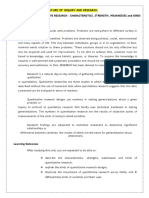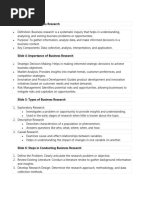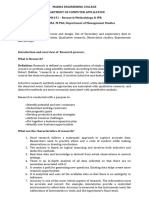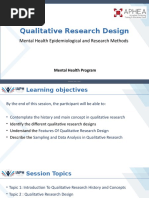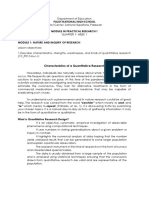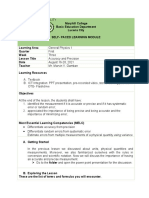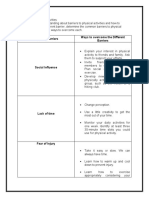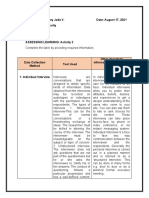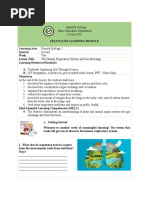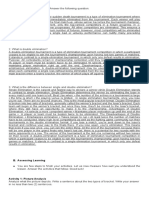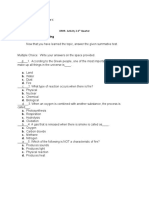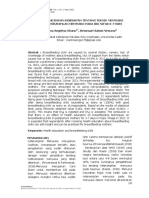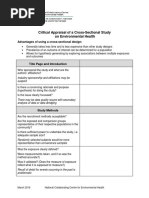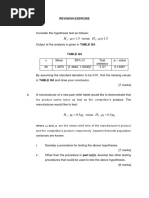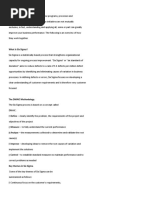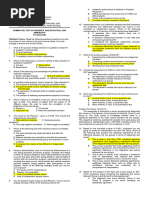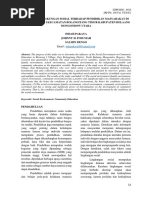Activity 1 and 2 - Domalanta, Ashley Jade V. (12-Charity)
Activity 1 and 2 - Domalanta, Ashley Jade V. (12-Charity)
Uploaded by
Ashley Jade DomalantaCopyright:
Available Formats
Activity 1 and 2 - Domalanta, Ashley Jade V. (12-Charity)
Activity 1 and 2 - Domalanta, Ashley Jade V. (12-Charity)
Uploaded by
Ashley Jade DomalantaCopyright
Available Formats
Share this document
Did you find this document useful?
Is this content inappropriate?
Copyright:
Available Formats
Activity 1 and 2 - Domalanta, Ashley Jade V. (12-Charity)
Activity 1 and 2 - Domalanta, Ashley Jade V. (12-Charity)
Uploaded by
Ashley Jade DomalantaCopyright:
Available Formats
Activity 1
In your own words, compare and contrast Qualitative and Quantitative research.
Quantitative and qualitative research methodologies are similar in that they’re
both involved in the collection and analysis of data. The big difference is that
whereas quantitative research methodology deals primarily with numbers and
statistics, qualitative research tends to deal with words and meaning.
Qualitative research involves the use of procedures that rely on findings
based on human reasoning and behavior. It engages research designs that
emphasize the collection of data that is related to naturally occurring
phenomena. The assessment of collected data does not involve any form of
enumeration but rather seek to understand the phenomena from which they
are obtained. Quantitative research on the other hand entails the use of
numbers, statistics, control and structure. Methods used in quantitative
research involve systematic prediction, determination and generalization of
findings to describe the data collected. The phenomena studied are compared
with their quantitative properties and the same can be extended to various
aspects of education. When comparing the two forms of research it is
apparent that quantitative research uses deductive mathematical models to
analyze the hypotheses formed in the study of natural phenomena while
qualitative research involves the use of prior knowledge to form
interpretations that are more subjective. Another difference between the two
forms of study is the nature of quantitative research being replicable as data
collected in a quantitative survey can be analyzed and used in the
comparison of a repeated study at a later time. Qualitative research is not
easily repeatable as it deals with inductive data that cannot be directly used
in comparison with data obtained with qualitative studies covered at a later
time.
Quantitative information is generated as measurable data. It is presented in
number format, for example percentages, participant numbers, sales figures,
raw numbers of stakeholders, level of usage or satisfaction. The purpose of
quantitative research is to provide narrow, focused and conclusive findings. It
is gathered to understand the extent of something tangible, it is effective in
providing a sharp and specific overview of what program activity has taken
place and to what extent. It may be collected through surveys, data analysis,
document review and stakeholder interviews. Quantitative research provides
facts that be easily digested by readers, it helps to set benchmarks for future
measures, and enables you to perhaps also understand how funding has
been spent. The limitation of relying on quantitative data alone is that it only
provides part of the picture and often obscures the more in-depth, more
meaningful, complex and nuanced aspects of a project or program. This is
where qualitative information is useful.
On the other hand, the primary aim of qualitative research is to explore more
broadly the intangible aspects of an evaluation or research topic. Qualitative
research is gathered as a way to provide depth of meaning to the numbers. It
is often collected through focus groups, videos in-depth interviews, case
studies and open-ended questions in surveys. Qualitative information
provides a rich picture of our project or program by helping to demonstrate
what difference we have made on a deeper level, on a ‘human’ scale. Of
course, there are also dangers in using qualitative information alone, as it can
make it difficult for the reader to understand the extent to which findings
represent the broader stakeholder or community group, it can make it
challenging for them to get a sense of how these anecdotes fit in the broader
picture.
Activity 2
Complete the missing information in the table given below.
Standards Qualitative Quantitative
Behavior toward 1. Desires to preserve the Control or manipulation of
research natural setting of research research conditions by the
aspects/conditions features researcher.
Obtaining knowledge Multiple methods Scientific method
Purpose 2. Makes social intentions 3. Evaluates objective
understandable and examines cause-
effect relationships
Data-analysis Thematic codal ways, 4. Mathematically based
technique competence-based methods
Sampling technique 5. More inclined to Random sampling as the
purposive sampling or use most preferred
of chosen samples based on
some criteria
You might also like
- Validation Tool (Test)Document2 pagesValidation Tool (Test)Reign-i Francisquite100% (10)
- Chapter 6. Qualitative and Quantitative Research MethodsDocument5 pagesChapter 6. Qualitative and Quantitative Research MethodsMariana BarreraNo ratings yet
- LAS Module 1 PR2 Ver 2 SecuredDocument6 pagesLAS Module 1 PR2 Ver 2 SecuredKhaira PeraltaNo ratings yet
- Ppe Research 2 - Week 1Document11 pagesPpe Research 2 - Week 1MARIE GRACE APARRENo ratings yet
- In Your Own Words, Compare and Contrast Qualitative and Quantitative ResearchDocument3 pagesIn Your Own Words, Compare and Contrast Qualitative and Quantitative ResearchAshley Jade DomalantaNo ratings yet
- Qualitative and Quantitative RESEARCHDocument16 pagesQualitative and Quantitative RESEARCHRichmond Jake AlmazanNo ratings yet
- Advantages and Disadvantages of Quantitative ResearchDocument4 pagesAdvantages and Disadvantages of Quantitative ResearchmackyjusainNo ratings yet
- Las in Practical Research 2 Week 1Document6 pagesLas in Practical Research 2 Week 1Moxy100% (1)
- BRM Unit 2Document9 pagesBRM Unit 2mohorsabui100No ratings yet
- MAC 802 Topic 2: When To Use Quantitative Research Methods When To Use Quantitative Research Methods: This Topic Is To Describe When To ChooseDocument6 pagesMAC 802 Topic 2: When To Use Quantitative Research Methods When To Use Quantitative Research Methods: This Topic Is To Describe When To Choosefashuanmi ibukunNo ratings yet
- Activity #1 (March 29, 2021) - Accounting Research MethodsDocument3 pagesActivity #1 (March 29, 2021) - Accounting Research MethodsErica DaprosaNo ratings yet
- ALICEDocument6 pagesALICESOMOSCONo ratings yet
- Unit 1: Nature of Inquiry and ResearchDocument11 pagesUnit 1: Nature of Inquiry and ResearchMagdalena BianesNo ratings yet
- Unit 1: Nature of Inquiry and ResearchDocument10 pagesUnit 1: Nature of Inquiry and ResearchJep DatulNo ratings yet
- Chapter 1 What Is Quantitative ResearchDocument10 pagesChapter 1 What Is Quantitative ResearchManoy KulaNo ratings yet
- Practical Research 2 SLM Q1 W1Document8 pagesPractical Research 2 SLM Q1 W1Sean LaguitNo ratings yet
- Supplementary Material - 001 - Nature of ResearchDocument7 pagesSupplementary Material - 001 - Nature of ResearchNashrin LomalaNo ratings yet
- Practical ResearchDocument142 pagesPractical ResearchVal Daryl Anhao100% (1)
- Admire S Mabhena Research Methods Ass 1Document3 pagesAdmire S Mabhena Research Methods Ass 1admire simbarashe MabhenaNo ratings yet
- PR2 Q1 Module1Document10 pagesPR2 Q1 Module1Edison MontemayorNo ratings yet
- Research DesignsDocument40 pagesResearch DesignsRubylita EnriquezNo ratings yet
- Pr2 SLM Lesson 1Document4 pagesPr2 SLM Lesson 1Aldrin AribNo ratings yet
- PR 2 - Handouts (WK 1-3)Document4 pagesPR 2 - Handouts (WK 1-3)Alrose HolgadoNo ratings yet
- Learning Kit - P.Research 2 - Week 1Document6 pagesLearning Kit - P.Research 2 - Week 1Frances Nicole FloresNo ratings yet
- PR 2 Topic 3Document21 pagesPR 2 Topic 3Jm BalessNo ratings yet
- Marketing ResearchDocument40 pagesMarketing Researchartee_aggrawal4312No ratings yet
- RESA Final Preboard P1Document10 pagesRESA Final Preboard P1carloNo ratings yet
- Summary Cresswell 2012 Chapter 1Document4 pagesSummary Cresswell 2012 Chapter 1urmoods20100% (1)
- MSC 4 RMDocument56 pagesMSC 4 RMDr. Mamta SinghNo ratings yet
- Practicalresearch2 Week1 3 Aug 1 13 2024Document46 pagesPracticalresearch2 Week1 3 Aug 1 13 2024perosomarkjoshua6No ratings yet
- Week 2Document65 pagesWeek 2theresita raval100% (1)
- research methodDocument4 pagesresearch methodhafsau435No ratings yet
- Research 2 SAMPLEDocument8 pagesResearch 2 SAMPLEJenn ImperialNo ratings yet
- ED 303 Handout Quanti vs. QualiDocument5 pagesED 303 Handout Quanti vs. Qualimaria.duran004No ratings yet
- Module 3Document14 pagesModule 3vaughnninolugueNo ratings yet
- Module 2 Pr2 1st QuarterDocument5 pagesModule 2 Pr2 1st QuarterJelsie BastawangNo ratings yet
- LAS PR2 MELC 1 Week 1Document10 pagesLAS PR2 MELC 1 Week 1Karlene Jade RidulfaNo ratings yet
- Business Research Slide ContentDocument6 pagesBusiness Research Slide ContentZAID gamerNo ratings yet
- Learning Activity August 18 2023Document7 pagesLearning Activity August 18 2023russelantonio2006No ratings yet
- Ares2 Lesson1Document7 pagesAres2 Lesson1Jochene Eve AldamiaNo ratings yet
- Unit-1 - Research Methods IPRDocument11 pagesUnit-1 - Research Methods IPRJinsad Sakkeer100% (1)
- Week 3 Task 2 Critically Compare and Contrast The Two Main Research Approaches With Special Focus On Their Differences 22may 2022Document11 pagesWeek 3 Task 2 Critically Compare and Contrast The Two Main Research Approaches With Special Focus On Their Differences 22may 2022AMTRISNo ratings yet
- Lectures Characteristics Strengths WeaknessesDocument41 pagesLectures Characteristics Strengths WeaknessesChianlee CarreonNo ratings yet
- 4 Qualitative Research DesignDocument47 pages4 Qualitative Research Designamarneh1969No ratings yet
- Pointers For Practical Research 2Document3 pagesPointers For Practical Research 2RyzaNo ratings yet
- W24 PR WMDDocument3 pagesW24 PR WMDYohan Kleir PuruggananNo ratings yet
- THEORY AND METHODS - IGCSE SociologyDocument14 pagesTHEORY AND METHODS - IGCSE SociologyMuhammad Ahmad NoorNo ratings yet
- Research Methodology: "Approaches To Research Methods"Document14 pagesResearch Methodology: "Approaches To Research Methods"Jaydwin LabianoNo ratings yet
- Unit 1: Nature of Inquiry and Research: What This Unit All About?Document3 pagesUnit 1: Nature of Inquiry and Research: What This Unit All About?Richard Tampog GaleraNo ratings yet
- Module-1 - Lesson-1 - 2 - 3 pr2Document24 pagesModule-1 - Lesson-1 - 2 - 3 pr2Aumii BasingaNo ratings yet
- Comparing Quantitative and Qualitative ResearchDocument2 pagesComparing Quantitative and Qualitative ResearchImanNo ratings yet
- 1 OverviewDocument28 pages1 OverviewMark Froilan LlanesNo ratings yet
- Unit 5 SociologyDocument2 pagesUnit 5 SociologyMukul KumarNo ratings yet
- 66d059e3920a49001871fcd8_##_Research Aptitude 03- Daily ClassnotesDocument11 pages66d059e3920a49001871fcd8_##_Research Aptitude 03- Daily Classnotessachin10ecoNo ratings yet
- PR2 Module1Document13 pagesPR2 Module1Ronnie DalgoNo ratings yet
- Data Collection Sem OldDocument62 pagesData Collection Sem OldAmy Lalringhluani ChhakchhuakNo ratings yet
- Qualitative vs. Quantitative ResearchDocument6 pagesQualitative vs. Quantitative ResearchChristia Abdel HayNo ratings yet
- Module 3: Nature and Inquiry OF ResearchDocument14 pagesModule 3: Nature and Inquiry OF ResearchJohn PaulNo ratings yet
- Grade: Self-Learning Module in PRACTICAL RESEARCH II LessonDocument6 pagesGrade: Self-Learning Module in PRACTICAL RESEARCH II LessonalagaodaisyNo ratings yet
- Unit 11Document14 pagesUnit 11thabani m chimbwandaNo ratings yet
- General Physics SPLM Week 3Document11 pagesGeneral Physics SPLM Week 3Ashley Jade Domalanta0% (1)
- Activity 3 - Domalanta, Ashley Jade v. (12-Charity)Document1 pageActivity 3 - Domalanta, Ashley Jade v. (12-Charity)Ashley Jade DomalantaNo ratings yet
- Assessing Learning 2 - Domalanta, Ashley Jade V. (12-Charity)Document2 pagesAssessing Learning 2 - Domalanta, Ashley Jade V. (12-Charity)Ashley Jade DomalantaNo ratings yet
- General Physics SPLM Week 3Document9 pagesGeneral Physics SPLM Week 3Ashley Jade DomalantaNo ratings yet
- Common Barriers Ways To Overcome The Different BarriersDocument2 pagesCommon Barriers Ways To Overcome The Different BarriersAshley Jade DomalantaNo ratings yet
- Activity 1 Solve Me !Document2 pagesActivity 1 Solve Me !Ashley Jade DomalantaNo ratings yet
- Assessing Learning (Activity 2) - MODULE 2Document7 pagesAssessing Learning (Activity 2) - MODULE 2Ashley Jade DomalantaNo ratings yet
- Assessing Learning - Domalanta, Ashley Jade V. (12-Charity)Document3 pagesAssessing Learning - Domalanta, Ashley Jade V. (12-Charity)Ashley Jade DomalantaNo ratings yet
- Assessing Learning (Activity 2) - MODULE 2Document1 pageAssessing Learning (Activity 2) - MODULE 2Ashley Jade DomalantaNo ratings yet
- Assessing-Domalanta, Ashley Jade V. (12-Charity)Document4 pagesAssessing-Domalanta, Ashley Jade V. (12-Charity)Ashley Jade DomalantaNo ratings yet
- Ashley Jade Domalanta - SPLM2-2Q-GENBIO2Document4 pagesAshley Jade Domalanta - SPLM2-2Q-GENBIO2Ashley Jade DomalantaNo ratings yet
- 3 I's SPLM 2 - Week 3 (YOUR GUIDE)Document5 pages3 I's SPLM 2 - Week 3 (YOUR GUIDE)Ashley Jade DomalantaNo ratings yet
- Self-Paced Learning Module: V L33RvphetikDocument7 pagesSelf-Paced Learning Module: V L33RvphetikAshley Jade DomalantaNo ratings yet
- Ashley Jade Domalanta - HG G11 Q1 Mod3 ASDocument6 pagesAshley Jade Domalanta - HG G11 Q1 Mod3 ASAshley Jade DomalantaNo ratings yet
- Ashley Jade Domalanta - PEH 11 ACTIVITIES 50 PtsDocument3 pagesAshley Jade Domalanta - PEH 11 ACTIVITIES 50 PtsAshley Jade DomalantaNo ratings yet
- Ashley Jade Domalanta - ACT 2 MOD1Document1 pageAshley Jade Domalanta - ACT 2 MOD1Ashley Jade DomalantaNo ratings yet
- Ashley Jade Domalanta - ACT 2 MOD1Document1 pageAshley Jade Domalanta - ACT 2 MOD1Ashley Jade DomalantaNo ratings yet
- DRRR Module 2 Week 2 4thQ AnswerDocument9 pagesDRRR Module 2 Week 2 4thQ AnswerAshley Jade DomalantaNo ratings yet
- Ashley Jade Domalanta - ACT 1 MOD1Document1 pageAshley Jade Domalanta - ACT 1 MOD1Ashley Jade DomalantaNo ratings yet
- DRRR - Activity 2 - 4th QDocument5 pagesDRRR - Activity 2 - 4th QAshley Jade DomalantaNo ratings yet
- New Microsoft Word DocumentDocument4 pagesNew Microsoft Word DocumentKhan TanoliNo ratings yet
- Sta 630Document27 pagesSta 630anroid appNo ratings yet
- Veer Narmad South Gujarat University, Surat Quantitative MethodsDocument1 pageVeer Narmad South Gujarat University, Surat Quantitative MethodskamleshddobariyaNo ratings yet
- How Research Instruments Are ValidatedDocument2 pagesHow Research Instruments Are ValidatedXy QuiñonesNo ratings yet
- 2078 337 4752 1 10 20180828 PDFDocument35 pages2078 337 4752 1 10 20180828 PDFMutia SilmaNo ratings yet
- DDDDDDDDDDDDDDDDDDDDDDDDDDocument2 pagesDDDDDDDDDDDDDDDDDDDDDDDDDCjls KthyNo ratings yet
- King, Keohane and Verba: Chapter 1+2Document19 pagesKing, Keohane and Verba: Chapter 1+2mom2jonahNo ratings yet
- WBCS Main Solved Question Paper 2017 GS I Indian History and Geography Set DDocument22 pagesWBCS Main Solved Question Paper 2017 GS I Indian History and Geography Set DMam TreumNo ratings yet
- Designing The Questionnaire & Establishing Validity & ReliabilityDocument30 pagesDesigning The Questionnaire & Establishing Validity & ReliabilityYvonne XyzelleNo ratings yet
- Correlation Assignment 1Document3 pagesCorrelation Assignment 1Sim PackNo ratings yet
- Basic Calculus (BACAL) Damath Strategy and The Academic Performance of Grade 12 STEM StudentsDocument22 pagesBasic Calculus (BACAL) Damath Strategy and The Academic Performance of Grade 12 STEM StudentsHannah Beatrice A. TamayoNo ratings yet
- Artikel 2Document14 pagesArtikel 2Habibah NursholihahNo ratings yet
- 10 - Osakuade Joseph OluwatayoDocument7 pages10 - Osakuade Joseph OluwatayoiisteNo ratings yet
- Critical Appraisal of A Cross-Sectional Study On Environmental HealthDocument2 pagesCritical Appraisal of A Cross-Sectional Study On Environmental HealthFaza Nurul WardhaniNo ratings yet
- Revision Exercise Hypothesis TestingDocument4 pagesRevision Exercise Hypothesis TestingQruisedNo ratings yet
- Questionnaire Development and ValidationDocument20 pagesQuestionnaire Development and ValidationRemelie Roque RoblesNo ratings yet
- Grade Book TeachersDocument14 pagesGrade Book Teachersalaa.djaaraneNo ratings yet
- Lian Polyan Watumlawar, Lakon Utamakno, Yudho Dwi Galih Cahyono Institut Teknologi Adhi Tama SurabayaDocument8 pagesLian Polyan Watumlawar, Lakon Utamakno, Yudho Dwi Galih Cahyono Institut Teknologi Adhi Tama SurabayaYosafat MalyoNo ratings yet
- GRE LinksDocument2 pagesGRE Linkshemanth_23No ratings yet
- Data CollectionDocument40 pagesData CollectionMohammed Ahmed AliNo ratings yet
- Reliability AnalysisDocument11 pagesReliability Analysisanhum jadoonNo ratings yet
- Six Sigma, ISO 9001 and BaldrigeDocument4 pagesSix Sigma, ISO 9001 and BaldrigeFrans JdNo ratings yet
- How To Critically Appraise A PaperDocument6 pagesHow To Critically Appraise A PaperAmbar RahmanNo ratings yet
- Summative Test Iii Fourth Quarter Answer KeyDocument3 pagesSummative Test Iii Fourth Quarter Answer KeyangelkenNo ratings yet
- Maths & Stats - Handbook of Parametric and Nonparametric Statistical Procedures - 3ed, 2004 (CRC PDFDocument1,184 pagesMaths & Stats - Handbook of Parametric and Nonparametric Statistical Procedures - 3ed, 2004 (CRC PDFAnonymous 48iNwCh33% (3)
- Scalling TechniquesDocument21 pagesScalling TechniquesVIKAS DOGRA0% (2)
- Pengaruh Lingkungan Sosial Terhadap Pendidikan Masyarakat Di Desa Biontong I Kecamatan Bolangitang Timur Kabupaten Bolaang Mongondow UtaraDocument8 pagesPengaruh Lingkungan Sosial Terhadap Pendidikan Masyarakat Di Desa Biontong I Kecamatan Bolangitang Timur Kabupaten Bolaang Mongondow UtaraHiragana AkioNo ratings yet
- QCA HandoutDocument2 pagesQCA Handoutyczgwr7zbyNo ratings yet
- 03.+Ujang+Rohman Wahana+hal+11-18Document8 pages03.+Ujang+Rohman Wahana+hal+11-18anindito29No ratings yet













